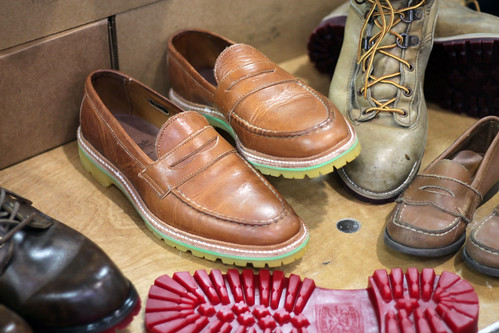Need to give your favorite boots a new lease on life? Find out how much it costs to get them resoled and make them good as new!

What Resoling Does
If your boots are showing signs of wear and tear, it’s time to consider resoleing them. This process of replacing the leather upper with a new piece can help prolong their life and keep them looking their best. Here’s a look at the cost of resoleing boots and what it entails.
The cost of resoleing boots will vary depending on the type of boot you have and the quality of the leather. For example, calfskin boots will cost more than rubber boots, because calfskin is a higher-quality leather. However, most boots can be resoleed for around $60-$80. This includes materials like new leather, thread, needles, and soles.
In order to resole a boot, you’ll first need to remove the old leather. This can be done by hand or with a machine. Once the old leather is removed, you can begin to replace it with new material. This new material will be cut to fit the shape of the boot and will be stitched together using thread and needles. Finally, you’ll apply a new sole to the boot and finish it off with a polish or wax.

Benefits of Resoling Boots
What is resole?
Resole is a term used to describe the process of restoring leather footwear or other leather goods to an original condition by replacing worn parts. There are many benefits of resoling boots: they can last for years, look new again, and help protect your feet from weather conditions and abrasion. In fact, properly repairing boots can even extend their lifespan by as much as 50%. Here are some reasons why you should consider resoling your boots:
- Boots usually last longer if they are kept in good condition. By resoiling your boots, you can keep them looking newer for longer.
- Leather footwear is susceptible to water damage, UV light exposure, and dirt build-up over time. By repairing your boots, you can prevent these problems from happening in the first place – which means they’ll be more resistant to wear and tear.
- Repairing damaged boot heels allows them to withstand pressure while walking or running without risk of heel slippage or dropping objects.
- By fixing small tears and scratches in boot toes (as well as filling any open areas with a special compound), you can make the shoes more weatherproof and easier to walk in without discomfort or slipping.”

Common Materials Used for Resoling
When it comes to boots, there are several materials that can be used to make them look and perform better. Here is a list of some of the most common materials used for resoling boots:
leather – Most boots are made out of leather. This material is prized because it is durable, water-resistant, and temperature sensitive. In fact, depending on the quality of the leather, a good resole could last up to 10 years or more.
suede – Suede is another popular material used for resoleing boots. It is a softer material than leather, but also less water-resistant and lighter in weight. Because suede has little structural support, it will wear down faster than either leather or nubuck.
nubuck – Nubuck is a type of calfskin that has been treated with a naphthol mixture to protect it from moisture and other environmental factors. It’s considered one of the highest quality materials available for boot repairs because its delicate texture makes it resistant to wear and tear while maintaining its elasticity over time.
Finding a Reputable Shoe Repair Service
Finding a reputable shoe repair service can be a daunting task. There are many unscrupulous businesses out there that will charge you exorbitant prices for simple repairs. If you’re looking for a good, reliable service, here are some tips to help you find one:
- Ask around. If you know anyone who has had good experiences with a particular repair service, ask them if they can recommend them.
- Look online. There are many reputable shoe repair services online, and you can find reviews of them to help you make a decision.
- Ask around at shoe stores. Many shoe stores have relationships with certain repair services and will be able to direct you to the right one.
- Ask your friends and family. If you know someone who is always losing their shoes or has had trouble repairing their own shoes in the past, ask them if they know of any good repair services.

How Much Will It Cost to Resole Boots?
Quality Matters
If you’re looking to replace your worn out boots, you’ll likely face several costs when doing so. In general, it can cost anywhere from around $10-$70 to have the boots resoled, depending on the quality of service chosen. However, there are often discounts available for those who foot the bill in full up front. Additionally, it’s important to factor in boot material and width when budgeting; some repairs require more complex work than others. So while a precise figure is difficult to pin down without doing further research, expect to pay somewhere between $10 and $70 for a good quality repair job on boots.
DIY vs Professional Resoling
How much does it cost to resole boots?
There are a few factors that will affect the price of a boot resoling job. The type of leather, the craftsmanship, and the number of repairs required will allividually impact the cost. Generally speaking, however, boot resoles generally run between $45 and $70 per pair. If you are interested in doing your own re-soling, here are some tips to help you save money:
- Examine your boots carefully before beginning any work – if there is significant damage or corrosion on the inside of the boot, it will be difficult or even impossible to repair without professional help.
- Make sure you have all of the required tools and supplies – a boot resolver will typically require a blowtorch, an awl, needle and thread, and polish.
- Be prepared to spend time – shoe repair is not a quick process, and you may need to wait several hours for the repairs to finish.
- If you decide to go with a professional resolver, be sure to ask about their rates – some offer discounts for students or veterans.
If you are considering repairing your boots yourself, there are a few key things that you should remember:
- Always take care when using tools – improper use can result in further damage or injury.
- Be patient – shoe repair takes time, but with patience and common sense it can be an easy and affordable project.
- Never use solvents or other dangerous chemicals – these can be harmful and may even result in fire.
Average Cost of Professional Resoling
There is no one answer to this question as the cost of resoleing boots will vary depending on the type of boot, the brand, the condition of the boot, and the skill of the repairer. However, in general, professional resoleing can cost anywhere from $50 to $200 per pair.
The average cost of professional resoleing is $100 per pair.
Saving Money on Boot Resole Services
Resoling boots is a necessary task that can be costly if not done correctly. Some boot repair services will charge anywhere from $60 to $300 for the service, and depending on the condition of the boots, additional fees may apply. Here are some tips to help you save money on resole services:
- Check reviews websites before deciding who to hire. There are many reputable resoling businesses out there, and by doing your research you can get a better idea of what kind of cost you might expect.
- Compare prices before hiring any boot repair service. Some companies offer discounts for bundling service with other types of repairs, such as shoes or calfskin boots.
- Inspect the boots before bringing them in for repair. If there are any tears or holes in the leather, it is likely that the repair will be more expensive than if the boots were in good condition to begin with.
- Be prepared to pay for labor as well as materials. Many boot repair services charge by the hour, and additional fees may apply for complicated repairs.

Tips on Keeping Your Boots in Good Condition
Resole your boots yourself to save money. Although boot resoling can be expensive, there are ways to keep the cost down. Follow these tips:
- When you first buy new boots, test the fit by walking in them for a few hours. If they’re too tight or too loose, go ahead and order your regular size rather than trying to stretch them; doing so could damage the boot’s construction.
- If you want to resole a pair of boots more than once, consider getting a custom job done. A professional will be able to better match the leather and stitching specifics of each individual pair of boots, preventingwear and tear along the seams over time.
- Apply sealant regularly if you generally wear your boots outside; this will help prevent moisture from causing cracks in the leather on contact with water or snow (a common cause of boot failure).

DIY Options For Resoling Shoes
Estimating Resoling Costs
There are many ways to repair shoes, but the most popular and affordable methods are called resoling. To resole a pair of boots, you’ll need the following supplies:
- New booties (if the boots have them)
- Nails
- Hammer or screwdriver
- Awl or needle
- Laces (if applicable)
- Shoe horn or chopstick (optional)
Before beginning, be sure to dry your boots completely. Doing so will help prevent moisture from causing early deterioration in the leather. If your boots don’t already come with new booties, you can use a shoemaker’s putty eraser to remove old shoe polish and dirt buildups. Apply a thin layer of putty to the eraser and use it to clean the boots. Be sure to use a light touch and avoid scrubbing the boots.
If your boots have laces, be sure to untie them before beginning. Next, take the new booties and fit them over the old ones. Make sure the toe is lined up correctly and press down evenly. Use a hammer or screwdriver to drive in the nails at a slight angle. If your boots have straps, be sure to tie them off before proceeding.
Now it’s time to reattach the laces. If your boots have a shoe horn or chopstick, use it to help guide the laces through the eyelets. If not, use an awl or needle to poke the laces through one at a time. Be sure to twist each lace once it’s through the hole, then pull it tight. Finally, reattach the strap.
To finish, use a shoe horn or chopstick to remove any excess putty and polish from around the nails. If your boots have straps, be sure to tie them off again before you leave.
DIY Resoling vs Professional Resoling
When it comes to keeping your shoes in good condition, there are a few things you can do on your own or with the help of a professional.
DIY Resoling vs Professional Resolding:
If you’re looking to mend or repair your shoes yourself, there are a few different tools and materials you’ll need. You can buy resoling glue and adhesives at most home improvement stores, or make your own mix using household ingredients like borax and water. You can also try using an air-conditioning compressor to create pressure while sticking the shoe to the sole; this will cause the adhesive to flow better. If you decide to go this route, be sure to wear gloves and safety goggles to avoid getting glue on your hands or eyes.
If you’re thinking of getting your shoes resoled by a professional, there are a few things to keep in mind. First, make sure you have the correct size shoes. Professional resolers use a special type of adhesive that only works with certain sizes of shoes, so if you don’t have the right size, you’ll have to go out and buy a new pair. Second, be sure to bring your shoes in well-maintained condition. If they’re dirty or damaged in any way, the professional resolver will not be able to do a good job. Finally, be prepared to pay a high price for professional resoling services.
Factors Affecting Resoling Costs
There are a few DIY options for resoling shoes, but they all have their own costs and benefits. One option is to use a heat gun or hair dryer to heat up the leather and then use a repair kit to fix the shoe. This option is relatively cheap, but it can take some time to do it correctly. Another option is to have a shoe repair shop do the work. This can be more expensive, but it’s usually faster and the shoes will be in better condition.
Other factors that affect resoling costs include the type of leather, the size of the hole, and the condition of the shoe.
Where to Find Professional Boot Resolers
Different types of boots require different levels of resoling. For example, cowboy boots often need more extensive repairs than dress shoes. If you’re not sure whether your boots need resoling, or which type of repair is necessary, ask a boot shop employee or search online for an authoritative source. An excellent resource is the Boot Repair Manual by Jan Sheehan (available through Amazon).
There are three main ways to Resole Boots: By Hand, With A Heelemaker, Or With A Shoe Maker.
By Hand
If you’re able to handle some basic hand tools and have some experience shoe repairing, this method is for you. To Resole Boots by Hand, follow these steps:
- Mark the location of the broken area on the boot with a pencil.
- Use a hammer to drive a screw into the mark.
- Remove the screw and pull out the broken piece of leather.
- Replace the broken piece of leather with a new one, using a needle and thread.
- Drive a new screw into the hole you created and tighten it with a hammer.
- Trim any excess thread with a knife.
With A Heelemaker
If you don’t have any experience repairing shoes, or if you’re not comfortable working with tools, consider hiring a professional heelemaker. Heelemakers use high-powered machines to Resole Boots, and they usually charge a fee for their services. To find a heelemaker in your area, visit the website of the National Shoe Repair Association or call a local shoe repair shop.
With A Shoe Maker
If you’re able to handle basic hand tools and you’re comfortable with a sewing machine, this is the method for you. To Resole Boots by Hand with a Shoe Maker, follow these steps:
- Mark the location of the broken area on the boot with a pencil.
- Sew the broken piece of leather together using a needle and thread.
- Trim any excess thread with a knife.
- Drive a new screw into the hole you created and tighten it with a hammer.
- Trim any excess thread with a knife.
Are There Less Expensive Alternatives To Professional Re-soling?
Average Cost for Resoling Boots
There are a few less expensive alternatives to professional re-soling boots. One option is to have a boot cobbler resole the boots for you. This can cost anywhere from $10 to $50, depending on the complexity of the job. Another option is to take your boots to a local shoe repair shop. They may be able to do a basic resole for around $10 or $15. However, this may not be ideal if you want your boots to look their best. A professional re-sole will usually cost around $35 to $50.
DIY vs Professional Resoling Options
There are a few less expensive options for re-soles when it comes to boot repair. DIY resoling can be done by yourself, but it is not recommended for most people. It can be tough and requires some skill, so it may not always produce satisfactory results. There are also some lower-cost professional resolers that offer subpar services at a lower price point. Before selecting a Professional Boot Resolver, it’s important to compare prices and reviews online to get the best deal.
Tips For Finding Affordable Boot Repair Services
If your boots are starting to show wear and tear, it may be time to consider re-soling them. Professional re-soles can run anywhere from $40-$120 per pair, but there are less expensive alternatives available if you’re willing to do some research. Here are a few tips for finding affordable boot repair services:
- Ask around. Friends, family, and co-workers may have friends or family who offer boot repairs at a fraction of the cost of professional services. If you don’t have any locally based options, online resources like Yelp can help you find businesses throughout your area with good reviews.
- Shop for used boots. If you’re on a tight budget, consider shopping for new boots on eBay or Craigslist and having the soles replaced by a professional later.
- Ask for help. If you’re not confident in your ability to fix boot repairs on your own, ask around for recommendations of reliable professionals. Many boot stores, shoe repair shops, and even some garages offer this type of service.
Whether you choose to re-sole your boots yourself or opt for cheaper alternatives, following these tips will help make the process as smooth as possible.

The Different Types Of Soles Available For Your Shoes
Factors Affecting Resoling Prices
There are many types of soles available for shoes, and each has its own advantages and disadvantages. Here are the most common types:
Cork Soles: Cork soles are the oldest type of sole, and they’re still used in some high-quality shoes. They’re made from compressed cork, which is a natural rubber. Cork soles are good for walking or running on hard surfaces, but they don’t work well on wet surfaces or in cold weather.
Rubber Soles: Rubber soles are the most common type of sole. They’re made from a mixture of rubber and plastic. Rubber soles are good for walking or running on hard surfaces, but they also work well on wet surfaces and in cold weather.
Gel-Soled shoes: Gel soles are a type of rubber sole that’s filled with a liquid gel. This makes the soles very flexible and allows them to conform to the shape of your foot. Gel soles are good for walking or running on hard surfaces, but they don’t work well on wet surfaces or in cold weather.
Plastic Soles: Plastic soles are made from a plastic material that’s shaped like a shoe sole. They’re usually light weight and tough, which make them good for walking or running on hard surfaces. However, they don’t work well on wet surfaces or in cold weather because they can get slippery.
Comparing Resoling Services
There are many types of soles available to repair boots, so it’s important to know what you need before choosing a service. You can choose from rubber, plastic or composite soles, depending on your needs.
Rubber and plastic soles are the cheapest and most common options, but they don’t last as long as composite or leather soles. Composite and leather soles are more expensive but they’re also more durable. If you have torn the seams on your boots or they’ve taken a beating over time, a composite or leather sole may be the best option for you.
Finding Affordable Resoling Options
When it comes to footwear, there are a range of options and materials available, from simple leather boots to high-tech running shoes. In addition to the variety of styles and colors on offer, there are also a number of different types of soles available for shoes – each with its own unique benefits and drawbacks.
The Different Types Of Soles Available For Your Shoes:
Plastic soles: Plastic shoe soles are generally cheap and durable, making them an affordable option for basic shoes. They’re not as lightweight as other types of soles, so they may not be ideal for dressier shoes, but they’re usually very comfortable. Some people dislike the sound they make when walking on hard surfaces.
Rubber soles: Rubber soles are generally more expensive than plastic ones, but they’re also more durable and lightweight. They make a noise when you walk on hard surfaces, but they’re less likely to slip and fall. They’re also better for shoes that need to be able to stand up to a lot of wear and tear.
Leather soles: Leather soles are the most expensive option, but they’re also the most durable and long-lasting. They make a sound when you walk on hard surfaces, but they’re also the most comfortable. They may require some conditioning after being used for the first time, but they’ll last for years if treated properly.
Finding Affordable Resoling Options:
There are a number of different companies that offer affordable resoling options for shoes. Many of these companies also offer restoration services for other types of leather goods, such as jackets and bags. It’s important to do your research before choosing a company, as not all options are equal. Look for companies with high customer satisfaction ratings, and make sure the soles you receive are genuine replacements rather than secondhand soles.

Popular Brands That Offer Re-Soles Or Replacements
There are many popular brands that offer re-soles or replacements for boots. Prices will vary depending on the type of boot and the brand, but in general, a re-sole or replacement will cost between $30 and $100.

What To Look For When Selecting A Replacement Sole
When selecting a replacement sole, there are a few things to look for.
The first thing to consider is the size of the boot. Many boots come in multiple sizes, so it is important to know your foot’s width and length. Next, make sure that the sole has enough cushioning. A good replacement sole will have some give and be flexible enough to contour to your feet’ every curve. The last thing to consider is cost. While not all replacements are created equal, most will fall within a certain price range.

The Pros and Cons of Doing It Yourself
There are pros and cons to doing your own resole work on boots. The main pro is that you can save money by doing it yourself, and you can also customize the fit of your boots to your own liking. The con is that you may not get the same quality of work as if you went to a professional resole shop.
Resoling your boots is a great way to extend their life and keep them looking good. It can be done professionally or as a DIY project, depending on your budget and skill level. No matter which option you choose, make sure to select the right materials and a reputable service provider. Doing so will ensure that your boots are properly resoled and last for many years to come. If you’re looking for more information on shoe care and repair, check out our other content for helpful tips and advice.


